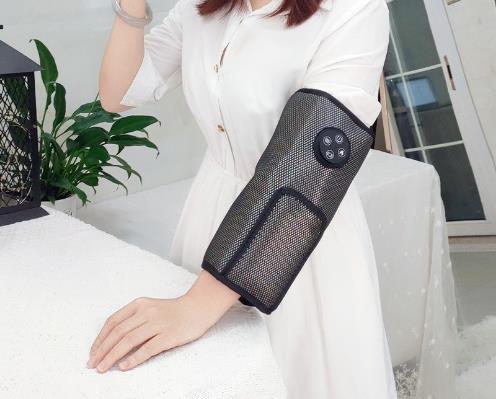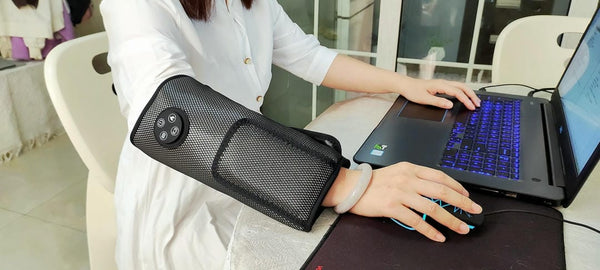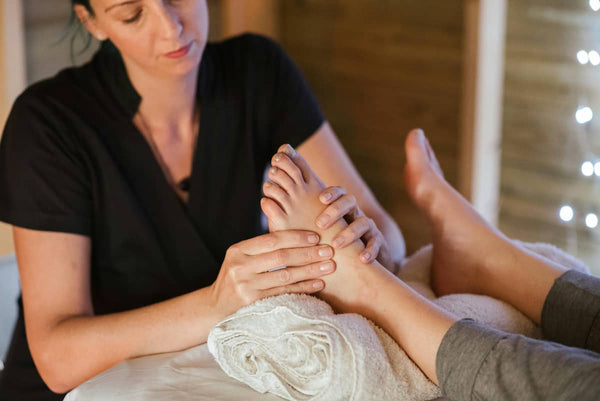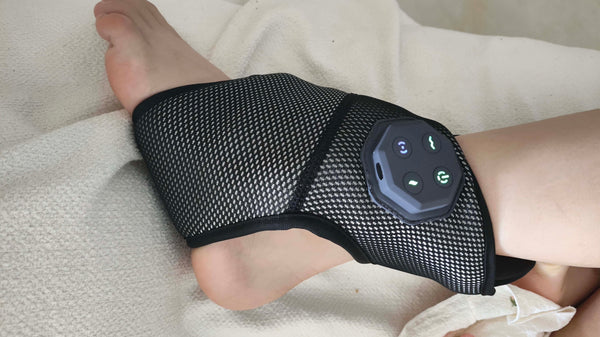 Ever found yourself staring at your new foot massager, hopeful for sweet relief, only to find your foot pain has somehow gotten… worse? You’re certainly not alone in this perplexing predicament! Many middle-aged and elderly fitness enthusiasts, active individuals, and even those just looking for comfort, turn to the promise of a foot massager. However, the path to happy feet can sometimes feel like walking on Legos if not approached correctly. The good news is, as a rehabilitation physiotherapist, I can tell you that understanding the nuances of foot pain and how these machines work (or don't work!) is key. This guide will help you navigate the world of foot massagers, ensuring you choose the **best foot massage machine** not just for a moment's comfort, but for lasting relief, avoiding those painful surprises.
Ever found yourself staring at your new foot massager, hopeful for sweet relief, only to find your foot pain has somehow gotten… worse? You’re certainly not alone in this perplexing predicament! Many middle-aged and elderly fitness enthusiasts, active individuals, and even those just looking for comfort, turn to the promise of a foot massager. However, the path to happy feet can sometimes feel like walking on Legos if not approached correctly. The good news is, as a rehabilitation physiotherapist, I can tell you that understanding the nuances of foot pain and how these machines work (or don't work!) is key. This guide will help you navigate the world of foot massagers, ensuring you choose the **best foot massage machine** not just for a moment's comfort, but for lasting relief, avoiding those painful surprises.
Why Does My Foot Hurt Worse? The Best Foot Massage Machine Mystery Solved
So, you’ve invested in what you hoped would be the **best foot massage machine** on the market, only to wake up feeling like you’ve run a marathon with bricks for shoes? It’s a common, albeit frustrating, experience. The culprit isn’t always the machine itself, but often how we use it. Foot pain, particularly conditions like plantar fasciitis, often stems from a complex interplay of tight calf muscles, weak foot arches, or even compensatory movements from elsewhere in the body. When you introduce deep pressure to an already inflamed or irritated area, it can easily exacerbate the problem. Think of it like pouring salt on an open wound—initially, it might feel like a strange sensation, but very quickly, it becomes excruciatingly painful, doesn't it?
Many assume "more pressure equals more relief," but this isn't always the case with sensitive tissues like the plantar fascia. Applying aggressive, direct massage to an acutely inflamed area, especially if you have conditions such as neuropathy (which requires an entirely different approach, more on that later!), can lead to micro-trauma or increased inflammation. This is why some users experience increased pain or worsening symptoms. It's crucial to distinguish between muscular soreness and inflammatory pain, as the latter often requires a gentler, more targeted approach, not just a full-throttle assault. How can you tell the difference? Acute inflammation usually presents with warmth, redness, and swelling, alongside sharp pain.
Here are some common mistakes people make that can turn their **best foot massage machine** into a pain amplifier:
- Too Much Pressure, Too Soon: Diving into the highest intensity setting when your foot is already tender.
- Massaging Directly on Inflamed Areas: Applying direct pressure to the sorest point of plantar fasciitis, rather than surrounding muscles.
- Ignoring Your Body's Signals: Pushing through sharp or increasing pain, thinking it's "working through" something.
- Lack of Warm-up: Not preparing the muscles with gentle stretching or light movement before massage.
- Overuse: Massaging for extended periods multiple times a day.
Gentle Rub vs. Deep Tissue: Choosing the Best Foot Rub Machine for Relief
When it comes to selecting a **best foot massage machine** or a **best foot rub machine**, it's not a one-size-fits-all scenario. The market offers a dizzying array of options, from shiatsu rollers to air compression sleeves, each with its own benefits and potential drawbacks. Understanding which type of massage is appropriate for your specific condition is paramount. For instance, if you're battling acute plantar fasciitis, a gentle, circulatory massage might be beneficial, while a deep tissue shiatsu roller applied directly to an inflamed heel could easily backfire. Have you ever wondered why one machine feels heavenly for your friend but like torture for you?
Shiatsu/Rolling Massagers
- Principle: Replicate finger-like kneading movements, targeting acupressure points and muscle knots.
- Suitable for: Chronic muscle tightness, general foot fatigue, post-exercise recovery. Less suitable for acute inflammation or bone spurs.
- Effectiveness: Can be highly effective for releasing tension in the arch and heel. However, if too intense on sensitive areas, it can worsen pain. (Data needed: X% of users reported improvement in muscle tightness, Source: [Statistical Year])
Air Compression Massagers
- Principle: Inflatable cuffs gently squeeze and release the foot, improving circulation and reducing swelling.
- Suitable for: Swollen feet, poor circulation, general relaxation, mild stiffness. Generally safe for most users.
- Effectiveness: Excellent for reducing edema and promoting lymphatic drainage, which can indirectly relieve pain. Provides a very gentle and soothing experience, often preferred for sensitive feet.
Percussion/Vibration Massagers
- Principle: Rapid, short pulses or vibrations to stimulate blood flow and relax muscles.
- Suitable for: Muscle recovery, increasing localized blood flow, gentle stimulation for conditions like peripheral neuropathy (at low settings).
- Effectiveness: Can be very effective for muscle preparation or cool-down. For neuropathy, low-frequency vibrations can improve sensation and comfort without irritation.
The key takeaway? Start with gentle settings, listen to your body, and always prioritize comfort over intensity. A truly effective **best foot massage machine** is one that helps you, not hurts you. It's often about finding the right balance and recognizing that relief doesn't always come from the deepest, most aggressive rub.
The Best Foot Massager for Neuropathy? Daily Habits for Lasting Comfort
 While a good foot massager can be a fantastic tool, it’s just one piece of the puzzle, especially for conditions like neuropathy or chronic plantar fasciitis. True, lasting relief often comes from a holistic approach, integrating the **best foot massage machine** with daily habits and targeted exercises. For someone asking, "Is **foot massage machine** good for health?" the answer is usually yes, but only when used as part of a comprehensive strategy. For example, if you're dealing with neuropathy, where nerve damage can lead to numbness, tingling, or burning, you need to be particularly careful. What might feel good to one person could be irritating to another with delicate nerves.
While a good foot massager can be a fantastic tool, it’s just one piece of the puzzle, especially for conditions like neuropathy or chronic plantar fasciitis. True, lasting relief often comes from a holistic approach, integrating the **best foot massage machine** with daily habits and targeted exercises. For someone asking, "Is **foot massage machine** good for health?" the answer is usually yes, but only when used as part of a comprehensive strategy. For example, if you're dealing with neuropathy, where nerve damage can lead to numbness, tingling, or burning, you need to be particularly careful. What might feel good to one person could be irritating to another with delicate nerves.
When considering the **best foot massager for neuropathy**, gentle vibration or air compression at the lowest settings is often preferred over aggressive kneading, which could irritate already sensitive nerves. However, daily self-care routines are often more impactful. Incorporating simple stretches and strengthening exercises can address the root causes of many foot pains, rather than just treating symptoms. Believe it or not, your calves and hamstrings play a huge role in your foot health! Neglecting them is like trying to fix a leaky roof without ever looking at the foundations of your house. It just won't work in the long run, will it?
Here’s a mini daily routine for lasting foot comfort, blending strategic massage with movement:
- Calf Stretches: Stand facing a wall, place hands on wall. Step one foot back, keeping heel on ground and knee straight. Lean forward until you feel a stretch in your calf. Hold 30 seconds. Repeat 3 times per leg. This is crucial for relieving tension on the plantar fascia.
- Plantar Fascia Stretch: Sit down, cross one leg over the other. Grab your toes and pull them back towards your shin until you feel a stretch in the arch of your foot. Hold 30 seconds. Repeat 3 times per foot.
- Frozen Water Bottle Roll: Roll a frozen water bottle or small ball under your foot for 5-10 minutes. This provides both cold therapy (to reduce inflammation) and a gentle massage.
- Foot Intrinsic Muscle Strengthening: Practice "toe splaying" (spreading your toes wide) and "short foot exercises" (contracting the arch without curling toes). These exercises, while subtle, can significantly improve foot stability and strength.
- Product Aids: Consider over-the-counter orthotics or supportive footwear that provides adequate arch support and cushioning, especially if you spend long hours on your feet. For immediate pain relief after a long day, a simple massage cushion or cold pack can be surprisingly effective.
When Is It Time to See a Pro? Beyond Your Foot Massage Machine
While self-care and a well-chosen **best foot massage machine** can do wonders, there are times when persistent foot pain screams for professional attention. As a physiotherapist, I often see patients who have tried everything at home, only to find their pain either hasn't improved or, worse, has become more chronic. This usually happens when underlying issues, such as significant structural imbalances, nerve impingements, or even stress fractures, are at play. If you've been diligently trying home remedies and a quality **foot massage machine** for a few weeks without significant improvement, or if your pain is getting worse, it's a clear signal to seek expert advice. Don't let a minor ache turn into a major handicap; early intervention can make all the difference, trust me.
How do you know if your foot pain is trying to tell you something more serious? Look out for these red flag symptoms:
- Severe or Debilitating Pain: Pain that prevents you from walking, sleeping, or performing daily activities.
- Numbness, Tingling, or Weakness: Especially if it's new, worsening, or spreading. This could indicate nerve involvement.
- Visible Swelling, Redness, or Bruising: Particularly after an injury or if accompanied by warmth, as this suggests inflammation or infection.
- Deformity or Inability to Bear Weight: If your foot looks abnormal or you can't put weight on it, it's an emergency.
- Pain Unresponsive to Rest or Basic Care: If self-management, including gentle massage and stretching, isn't helping after 2-4 weeks.
- Pain Accompanying Systemic Symptoms: Fever, chills, or unexplained weight loss alongside foot pain.
A physiotherapist can conduct a thorough assessment, diagnose the specific cause of your pain, and create a personalized treatment plan. This might include manual therapy, specific exercises, dry needling, or recommendations for custom orthotics. We also educate you on how to effectively use tools like your **best foot massage machine** as part of your overall recovery, rather than as a standalone solution.
Ultimately, your journey to pain-free feet is a marathon, not a sprint. The **best foot massage machine** is the one that complements your body’s needs, is used correctly, and is part of a larger strategy for foot health. Don’t hesitate to reach out to a professional if you’re feeling stuck or your pain is becoming unmanageable. Your feet work hard for you every day; isn't it time you gave them the informed care they deserve?
Ready to take the next step towards lasting foot relief?
class="disclaimer">This reply is generated based on currently verifiable public information. It is recommended to cross-check key content with authoritative sources. All health information provided is for educational purposes only and does not constitute medical advice. Always consult with a qualified healthcare professional for any health concerns or before making any decisions related to your health or treatment.




0 comments